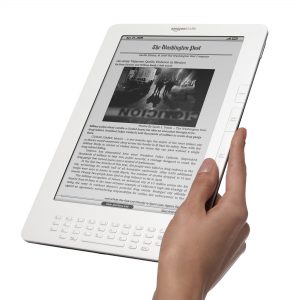My iPad arrived, delivered by Aramex to my doorstep in Dubai. Why Aramex? Because Aramex ships items purchased online from Amazon and other online retailers to Dubai.
Pretty packaging surrounded the much-anticipated gadget, but this is exactly what one could expect from Apple. Opening the box, it does look a lot like a giant iPod touch – the back of the device is made of the same brushed aluminum that houses the MacBook Pro . But this is neither of these – this is the iPad
.
As a a consumer who loves toys, but is not an engineer, a designer or pro computer person, I can’t be easily impressed, especially as self confessed Kindle fan, since the first Kindle
was produced back in 2007. After checking what Sony has to offer, along with other devices, my conclusion is that nothing can part me thus far from the Kindle
as this latest Apple gadjet.
The iPad is a bit hefty. It’s larger and weighs a bit more than the Kindle
. The screen size more resembles the large format Kindle
than the standard version.
The reading experience on the iPad is naturally the most interesting one, as the device has been touted as the potential Kindle Killer in the media by some. So, after familiarizing myself with the iPad, syncing the iPod apps and iTunes library, I downloaded the iBook app, Apple’s iPad reader application. The interface is gorgeous as you gaze upon the wood-like empty bookshelves of your personal library, that contains a lone copy of Winnie the Pooh, which is the standard equipment on an iPad.
Reading on the iBook app is a great experience. There are two things one notice right away using the iBook application. First, the books are in color, something technologically impossible on the Kindle and other similar eReaders. The second thing you notice is the navigation. On the Kindle you turn pages by pressing a button. Depending on the eReader, the page turns either slowly—or extremely slowly. There is a significant lag time between the button-push and the actual turn of page.
 Reading in iBook is a completely different experience. The page turns as you turn the page, without a lag. Sweeping a finger at the page edge causes the page to turn. The faster you sweep, the quicker you leaf through the pages. As on Kindle
Reading in iBook is a completely different experience. The page turns as you turn the page, without a lag. Sweeping a finger at the page edge causes the page to turn. The faster you sweep, the quicker you leaf through the pages. As on Kindle , the font size size can be manipulated.
One of the big selling points of standalone eReaders is that they’re reproduced using something called e-Ink. E-Ink provides the reader with a book-like feel and no backlighting ,which is theoretically easier on the eyes, because it’s not so bright. The absence of backlighting and relative simplicity of the device also means that there is virtually no battery drain while reading. The Kindle ’s battery lasts for weeks with its onboard wireless signal disabled.
One of the best things about the Kindle , and what puts it at the top of the eReader market, is the ease of purchasing sheer number of available books. You can buy a book online at the Amazon’s Kindle bookstore
or access the Kindle store
directly from the Kindle wirelessly and at no charge via built-in wireless capability. Download a sample to “try before you buy†or the buy the book and within a couple minutes it’s in your library and ready for reading. And the $9.99 price tag for most books, including new releases, is very attractive.
Envisioning the coming iPad wave, Amazon has done a spectacular job in creating Kindle for iPad. Although the Apple iBook app is excellent, Kindle has done even in some respects better. When you launching the free Kindle app, after signing in to account, the software recognizes the user and asks if readers would like to download anything from already archivated books. The settings give a choice of reading backgrounds: white, sepia or black. Sepia resembles a physical printed page. Brightness and the font size are easy to adjust too. Page turning is effortless and instantaneous.
The iPad’s touch screen allows you to touch any word, phrase, or entire section for easy note-taking on the generous pop-up virtual keyboard. In the iBook app, when you highlight a word, you also have the option of looking it up in the dictionary—or searching the term on Google or in Wikipedia.
Searching within a book is simple, fast, and seamless in either application like using a word search function in Word or in an Internet browser. Some books have hyperlinks, which come in very handy when using a cookbook or reference book. Buying books is easy, as the app directs you to the Amazon.com Kindle store in a browser, enabling you to search and buy to your heart’s content.
The Kindle app is fantastic and Kindle is most probably the best devise for the conventional eReaders. But the powerful combination of Apple technology with the iPad and Kindle’s bookstore with reading app make Kindle for iPad is the most powerful combination providing readers with the best reading experience. With the iPad priced from $499 (Dh1835) onwards, only a little more than the large-scale Kindle DX, the iPad may well be the preferred consumer’s choice.


































